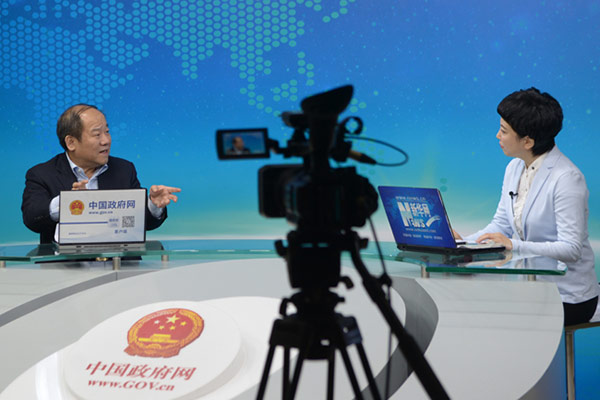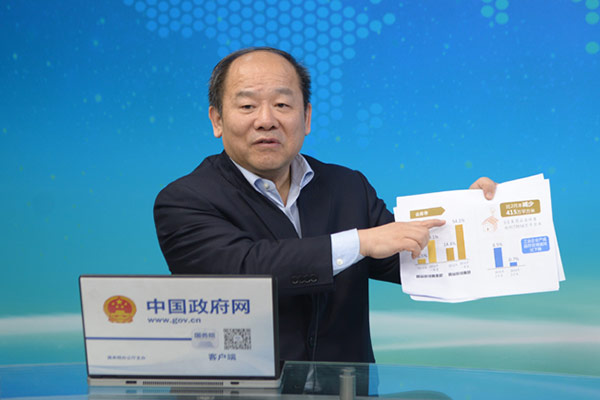
Ning Jizhe, head of the National Bureau of the Statistics (NBS), introduces the economic situation in the first quarter of 2016 in an interview on April 19. [Photo/gov.cn]
Ning Jizhe, head of the National Bureau of the Statistics (NBS), introduced the economic situation in the first quarter of 2016 and interpreted related data from aspects of the GDP growth, employment, prices and industrial structure in an interview on April 19.
Impressive data
Ning Jiezhe said the most impressive data in the first quarter is the GDP’s year-on-year increase of 6.7 percent. The economic growth speed greatly surpassed developed economies, including the United States, Japan and Germany.
The unemployment rate in the first quarter was 5.12 percent with a decline of 0.07 percent compared to the same period of last year, according to the NBS’s data collected from 31 big cities.
Talking about prices, Ning said the Consumer Price Index (CPI) grew 2.1 percent in the first quarter, still leaving some space to this year’s expected target of 3 percent.

Ning Jizhe, head of the National Bureau of the Statistics (NBS), introduces the economic situation in the first quarter of 2016 in an interview on April 19. [Photo/gov.cn]
Positive changes
The statistics chief also introduced some positive changes in economic development in the first quarter. He said that the trend of declining investment growth was reversed, with an increase of 10.7 percent in fix asset investment, growing 0.7 percentage points compared to the overall growth rate of last year.
Meanwhile, the industrial production returned to the stable status with a year-on-year increase of 5.8 percent in the first quarter. The decline of the Producer Price Index (PPI) slowed down. This index in March achieved it first positive growth since January 2014.
In addition, both the area and amount of real estate sales in the first quarter increased, respectively over 30 percent and 50 percent. The Purchasing Managers’ Index (PMI) in March was back to 50.2 percent after a longtime decline.

Ning Jizhe, head of the National Bureau of the Statistics (NBS), introduces the economic situation in the first quarter of 2016 in an interview on April 19. [Photo/gov.cn]
Concerns on Q2’s data
When answering what he was most concerned with in the data of the second quarter, Ning mentioned some data relating to the industrial, investment and consumption structures.
He said the development of the service industry is still at a lower level, compared to developed countries. The investment in the service industry rose 12.6 percent in the first quarter and the investment in the high-tech industry and strategic emerging industries both witnessed an increase of double digits. It reflects a good change in the future economic structure. Moreover, the Engel coefficient dropped about 30 percent. It is also a very important indicator of economic transformation, Ning added.
New economy’s statistics
The National Bureau of Statistics is improving statistics on the new industries, new commercial activities and new business models in efforts to reflect the overall development of the new economy, Ning said. At present the bureau can present some data related to Internet sales, logistics and circulation, and product delivery. A statistics data network concerning the new economy is expected to be set up within this year, the chief said.
In the online interview, Ning also answered questions from netizens, related to vegetable and house prices, real estate market and employment.
